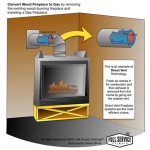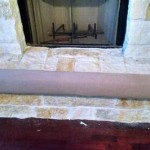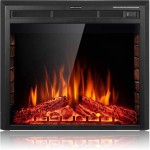Understanding TV Over Fireplace Heat Shields: Protecting Your Entertainment Investment
Mounting a television above a fireplace has become a popular design choice, offering a visually appealing focal point for living rooms and entertainment spaces. However, this configuration presents a significant challenge: the heat generated by the fireplace can damage the sensitive electronic components of the television. A TV over fireplace heat shield is a crucial accessory designed to mitigate this risk, protecting your investment and ensuring the longevity of your television.
The primary function of a fireplace is to generate heat, often reaching temperatures that far exceed the operational tolerances of electronic devices like televisions. Prolonged exposure to excessive heat can lead to a variety of problems, including screen discoloration, pixel damage, component failure, and even a shortened lifespan for the TV. Heat shields act as a barrier, deflecting rising heat and reducing the temperature gradient in the area directly above the fireplace where the television is mounted.
Properly selecting and installing a heat shield is critical to achieving optimal protection. Several factors must be considered, including the type and size of the fireplace, the distance between the fireplace and the television, and the construction materials of both the fireplace surround and the heat shield itself. Ignoring these considerations can render the heat shield ineffective or, in some cases, even exacerbate the problem by trapping heat.
Key Point 1: How Heat Shields Work
Heat shields operate on several principles of thermodynamics to reduce the amount of heat reaching the television. They primarily use conduction, convection, and radiation to achieve this. Conduction involves the transfer of heat through direct contact. The heat shield material, typically metal, absorbs heat from the rising air and conducts it away from the area directly above the fireplace.
Convection is the process of heat transfer through the movement of fluids, in this case, air. Heat shields are designed to create a physical barrier that disrupts the natural convection currents rising from the fireplace. This disruption prevents hot air from directly reaching the television and redirects it away from the screen.
Radiation is the emission of energy as electromagnetic waves. Fireplaces radiate heat in all directions, including upwards towards the television. A heat shield with a reflective surface can minimize radiant heat transfer by reflecting the heat back into the room instead of allowing it to be absorbed by the television.
The effectiveness of a heat shield depends on its design and the materials used. Metal shields, particularly those with a reflective finish, are generally more effective at reflecting radiant heat. The size and shape of the shield also play a crucial role in creating an adequate barrier against convection currents.
Key Point 2: Selecting the Right Heat Shield
Choosing the appropriate heat shield requires careful consideration of several factors. The type and size of the fireplace is a primary determinant. A large, open-hearth fireplace will generate significantly more heat than a small, enclosed gas fireplace. The heat shield must be sized accordingly to provide adequate coverage.
The distance between the fireplace and the television is another critical factor. The closer the television is to the fireplace, the more intense the heat exposure. In such cases, a more robust heat shield with enhanced insulation may be necessary. Building codes and manufacturer recommendations should always be consulted for minimum clearances.
Material selection is also crucial. Metal heat shields, often constructed from aluminum or steel, are generally preferred due to their high thermal conductivity and reflectivity. However, the thickness of the metal is also important. A thicker shield will provide better thermal insulation and durability. Some heat shields incorporate additional insulation materials, such as ceramic fiber blankets, to further enhance their heat-blocking capabilities.
Finally, aesthetics should also be considered. While functionality is paramount, the heat shield should ideally blend seamlessly with the surrounding décor. Many manufacturers offer a variety of finishes and designs to complement different fireplace styles and room aesthetics.
Key Point 3: Installation and Maintenance
Proper installation is paramount to ensuring the effectiveness of a heat shield. Incorrect installation can compromise its ability to protect the television and may even create a fire hazard. It is essential to follow the manufacturer's instructions carefully and to consult with a qualified professional if needed.
The mounting hardware used to secure the heat shield should be robust and capable of supporting the weight of the shield. The shield should be securely attached to the fireplace surround or the wall above the fireplace, ensuring that it is stable and does not vibrate or shift during fireplace use.
Regular maintenance is also important to ensure the continued effectiveness of the heat shield. This includes periodically inspecting the shield for damage, such as cracks or dents, and cleaning it to remove any accumulated dust or soot. A clean, reflective surface is more effective at reflecting radiant heat.
It is also advisable to monitor the temperature above the fireplace, even with a heat shield installed. This can be done using a simple thermometer or a more sophisticated temperature sensor. If the temperature consistently exceeds the recommended operating range of the television, additional measures may be necessary, such as adding insulation or increasing the distance between the fireplace and the television.
In addition to the heat shield itself, consider other strategies to mitigate heat exposure. Reducing the burn time of the fireplace, using a fireplace screen to block radiant heat, and ensuring adequate ventilation in the room can all contribute to protecting your television. These combined efforts offer a comprehensive approach to managing heat exposure and preserving the lifespan of your entertainment equipment.

5 Ways To Protect Your Tv From The Heat Of Fireplace Tips

5 Ways To Protect Your Tv From The Heat Of Fireplace Wall Living Room Decor Over

Mantleflect Shield Above Fireplace Ideas Outdoor Remodel Tv

Mounting A Tv Above Fireplace 5 Things To Consider

5 Ways To Protect Your Tv From The Heat Of Fireplace Tips

Heatshield Mantleflect 5 Inch X 47 Set Of 2 Rolls
Mount Tv Above Stove Hearth Com Forums Home

Coolsmart Heat Vent No Need For A Mantle To Shield Tv

How To Protect The Tv From Fireplace Heat Go Firepit

3 Myths About Mounting Tvs Over Fireplaces Monmouth County








